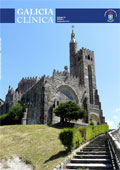Abstract
RESUMEN/ABSTRACT:
Objetivo: Describir las características clínicas y terapéuticas de los pacientes con accidente isquémico transitorio (AIT), atendidos en el Servicio de Urgencias de nuestro hospital, de 2006 a 2008, subsidiarios de ingreso.
Material y Método: Estudio descriptivo de prevalencia retrospectivo de 367 pacientes atendidos en el Servicio de Urgencias del Complejo Hospitalario Universitario A Coruña, que fueron ingresados con diagnóstico de AIT, entre enero de 2006 y diciembre de 2008.
Resultados: La realización de pruebas complementarias fue relevante en el 15,6% de los electrocardiogramas, 7% de las tomografías computarizadas (TC) craneales, 15,2% de los ecodoppler de troncos supraórticos (TSA) y 25,7% de los ecocardiogramas. 1,9% de los pacientes presentaron alguna complicación cardioembólica durante el ingreso hospitalario. En cuanto al tratamiento al alta, al 82,1% de los pacientes se les recomendó mantener tratamiento antiagregante. La estancia media hospitalaria fue de 9,5 días con una desviación típica de ± 9,1.
Conclusiones: Valorar si existe la necesidad de mejorar la calidad asistencial y economización de recursos en base a los hallazgos obtenidos.
Objective: Describe the clinical features and treatment of patients with transient ischemic attack (TIA), who attended the Emergency Department of our hospital, from 2006 to 2008, subsidiary of income.
Material and method: I study descriptive of 367 patients' retrospective prevalencia assisted in the Service of Urgencies from the Complex Hospital University student TO Coruña that were entered with diagnosis of AIT, between January of 2006 and December of 2008.
Results: The realization of additional evidence was relevant in the 15.6 % of electrocardiograms, 7% of the computed tomographic (CT) cranial nerves, 15.2 % of the log ecodoppler supraorticos (TSA) and 25.7 % of the echocardiogram. 1.9 % Of the patients presented a complication cardioembolica during a hospital admission. In regard to the treatment high, 82.1 % of the patients were recommended to maintain antiplatelet therapy.
Conclusions: Assess if there is a need to improve the quality of care and economisation of resources based on the findings obtained.
© 2013 Galicia Clínica.
Complete article | Pdf article


